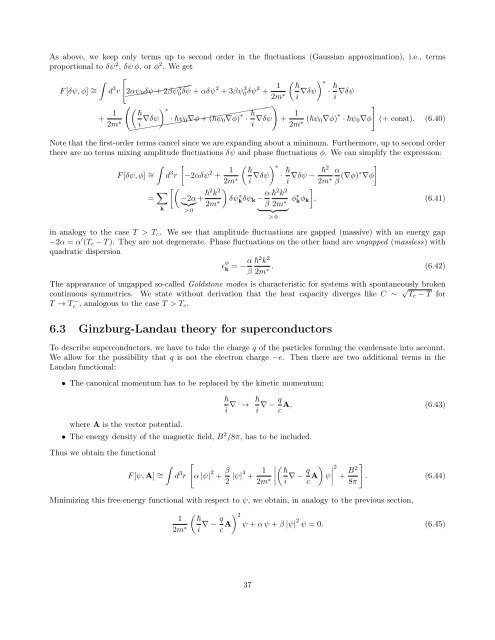Carsten Timm: Theory of superconductivity
Carsten Timm: Theory of superconductivity
Carsten Timm: Theory of superconductivity
Create successful ePaper yourself
Turn your PDF publications into a flip-book with our unique Google optimized e-Paper software.
As above, we keep only terms up to second order in the fluctuations (Gaussian approximation), i.e., terms<br />
proportional to δψ 2 , δψ ϕ, or ϕ 2 . We get<br />
∫ [<br />
F [δψ, ϕ] ∼ ✭<br />
= d 3 r ✭✭✭✭✭✭✭<br />
2αψ 0 δψ + 2βψ0δψ 3 + αδψ 2 + 3βψ0δψ 3 2 + 1 ( ) ∗ <br />
2m ∗ i ∇δψ · <br />
i ∇δψ<br />
(<br />
+ 1 ( ) )<br />
]<br />
∗ <br />
2m<br />
✭✭✭✭✭✭✭✭✭✭✭✭✭✭✭✭✭✭<br />
∗ i ∇δψ · ψ 0 ∇ϕ + (ψ 0 ∇ϕ) ∗ · <br />
i ∇δψ + 1<br />
2m ∗ (ψ 0∇ϕ) ∗ · ψ 0 ∇ϕ (+ const). (6.40)<br />
Note that the first-order terms cancel since we are expanding about a minimum. Furthermore, up to second order<br />
there are no terms mixing amplitude fluctuations δψ and phase fluctuations ϕ. We can simplify the expression:<br />
[<br />
−2αδψ 2 + 1<br />
2m ∗ ( <br />
i ∇δψ ) ∗<br />
· <br />
i ∇δψ −<br />
∫<br />
F [δψ, ϕ] ∼ = d 3 r<br />
= ∑ [(<br />
−2α + 2 k 2 )<br />
}{{} 2m ∗ δψkδψ ∗ k − α β<br />
k > 0<br />
2 k 2<br />
2m ∗<br />
} {{ }<br />
> 0<br />
]<br />
2 α<br />
2m ∗ β (∇ϕ)∗ ∇ϕ<br />
ϕ ∗ kϕ k<br />
], (6.41)<br />
in analogy to the case T > T c . We see that amplitude fluctuations are gapped (massive) with an energy gap<br />
−2α = α ′ (T c − T ). They are not degenerate. Phase fluctuations on the other hand are ungapped (massless) with<br />
quadratic dispersion<br />
ϵ ϕ k = −α 2 k 2<br />
β 2m ∗ . (6.42)<br />
The appearance <strong>of</strong> ungapped so-called Goldstone modes is characteristic for systems with spontaneously broken<br />
continuous symmetries. We state without derivation that the heat capacity diverges like C ∼ √ T c − T for<br />
T → Tc − , analogous to the case T > T c .<br />
6.3 Ginzburg-Landau theory for superconductors<br />
To describe superconductors, we have to take the charge q <strong>of</strong> the particles forming the condensate into account.<br />
We allow for the possibility that q is not the electron charge −e. Then there are two additional terms in the<br />
Landau functional:<br />
• The canonical momentum has to be replaced by the kinetic momentum:<br />
where A is the vector potential.<br />
• The energy density <strong>of</strong> the magnetic field, B 2 /8π, has to be included.<br />
<br />
i ∇ → i ∇ − q A, (6.43)<br />
c<br />
Thus we obtain the functional<br />
∫<br />
F [ψ, A] ∼ =<br />
[<br />
d 3 r α |ψ| 2 + β 2 |ψ|4 + 1 ∣( ∣∣∣ <br />
2m ∗ i ∇ − q )<br />
c A ψ<br />
∣<br />
2<br />
+ B2<br />
8π<br />
]<br />
. (6.44)<br />
Minimizing this free-energy functional with respect to ψ, we obtain, in analogy to the previous section,<br />
1<br />
2m ∗ ( <br />
i ∇ − q c A ) 2<br />
ψ + α ψ + β |ψ| 2 ψ = 0. (6.45)<br />
37

















